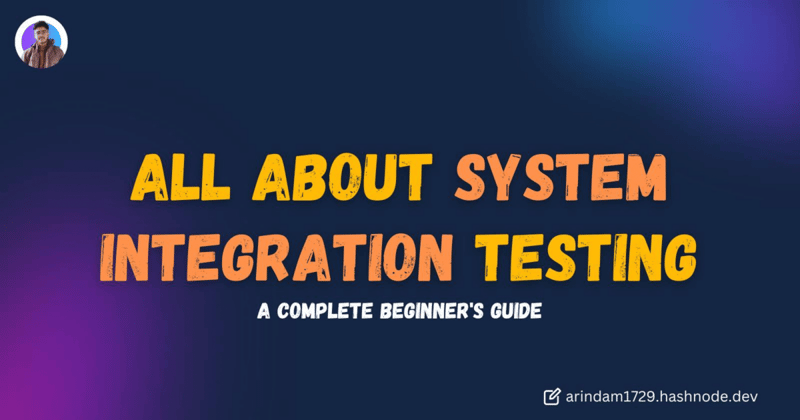 Web Front-end
Web Front-end
 JS Tutorial
JS Tutorial
 System Integration Testing: Ensuring Seamless Collaboration Between Components
System Integration Testing: Ensuring Seamless Collaboration Between Components
System Integration Testing: Ensuring Seamless Collaboration Between Components
Jan 23, 2025 pm 04:38 PM
System integration testing (SIT) is crucial in software development, ensuring seamless interaction between system components. This process validates component collaboration, preventing integration problems that could impact application performance. This blog post explores SIT's importance, process, challenges, best practices, and useful tools.
What is System Integration Testing?
SIT tests the interactions between different modules or systems as a unified whole. Unlike unit testing, which focuses on individual components, SIT verifies their harmonious operation, validating data flow, interaction, and overall functionality.
Why is System Integration Testing Important?
Modern applications often rely on multiple components, external systems, and APIs. SIT ensures effective communication between these elements, preventing data inconsistencies, workflow disruptions, and unhandled exceptions. Successful SIT is vital for seamless user experiences and reliable software.
Key Objectives of System Integration Testing:
- Data Flow Verification: Ensuring accurate and consistent data exchange between components.
- Component Interaction Validation: Confirming that integrated systems function as designed without conflicts.
- Early Issue Identification: Detecting potential problems during testing to avoid costly post-deployment fixes.
Types of System Integration Testing:
- Big Bang Integration: All components are integrated and tested simultaneously. While comprehensive, it can make troubleshooting difficult.
- Incremental Integration: Components are integrated and tested in smaller groups, enabling step-by-step validation and easier debugging.
- Top-Down Integration: Testing starts with high-level modules, progressively adding and validating lower-level components. This prioritizes major workflow functionality.
- Bottom-Up Integration: Testing begins with lower-level modules, gradually integrating higher-level components. This approach verifies the system's foundation before adding complexity.
System Integration Testing Process:
- Requirement Analysis: Defining the integration scope, identifying components, data flow, and interactions for testing.
- Test Planning: Establishing the test strategy, tools, resources, and timelines.
- Test Case Design: Developing test cases covering all integration scenarios, including edge cases and potential failures.
- Environment Setup: Creating a test environment closely mirroring the production environment.
- Execution and Validation: Executing test cases, validating results, and ensuring interactions meet requirements.
- Defect Reporting and Resolution: Documenting issues, prioritizing resolution, and retesting fixes.
Challenges in System Integration Testing:
- Complex Interactions: Testing interconnected components can be challenging, especially in large systems.
- Third-Party Component Dependencies: External APIs or services might be inaccessible or unreliable during testing.
- Environment Configuration: Setting up a realistic test environment can be time-consuming and resource-intensive.
Best Practices for Effective System Integration Testing:
- Clear Integration Goals: Establishing specific benchmarks and expected outcomes.
- Realistic Test Data: Using real-world scenarios to uncover hidden issues.
- Automation Tools: Automating repetitive tests for efficiency and accuracy.
- Cross-Team Collaboration: Fostering communication between development, testing, and operations teams.
- Monitoring and Optimization: Continuously analyzing SIT results and refining testing strategies.
Tools for System Integration Testing:
- Postman: A versatile API integration testing tool with automation capabilities.
- Selenium: Automates testing for web-based integrations.
- SoapUI: Ideal for testing SOAP and REST APIs in complex integration scenarios.
- Tosca: Provides end-to-end automation for intricate system integrations.
System Integration Testing vs. Unit Testing:
Unit testing validates individual components in isolation, while SIT ensures effective communication between integrated components. SIT identifies issues like data format mismatches and broken workflows that unit testing might miss.
Case Study:
A fintech company used SIT to validate the integration between its payment gateway and transaction processing system. Testing identified and resolved critical data mapping issues, preventing potential revenue loss and customer dissatisfaction.
Conclusion:
System integration testing is essential for delivering reliable software systems. A structured process, appropriate tools, and best practices ensure seamless component interaction. Investing in robust SIT improves software quality, builds trust, and enhances user satisfaction.
The above is the detailed content of System Integration Testing: Ensuring Seamless Collaboration Between Components. For more information, please follow other related articles on the PHP Chinese website!

Hot Article

Hot tools Tags

Hot Article

Hot Article Tags

Notepad++7.3.1
Easy-to-use and free code editor

SublimeText3 Chinese version
Chinese version, very easy to use

Zend Studio 13.0.1
Powerful PHP integrated development environment

Dreamweaver CS6
Visual web development tools

SublimeText3 Mac version
God-level code editing software (SublimeText3)

Hot Topics
 Replace String Characters in JavaScript
Mar 11, 2025 am 12:07 AM
Replace String Characters in JavaScript
Mar 11, 2025 am 12:07 AM
Replace String Characters in JavaScript
 HTTP Debugging with Node and http-console
Mar 01, 2025 am 01:37 AM
HTTP Debugging with Node and http-console
Mar 01, 2025 am 01:37 AM
HTTP Debugging with Node and http-console
 Custom Google Search API Setup Tutorial
Mar 04, 2025 am 01:06 AM
Custom Google Search API Setup Tutorial
Mar 04, 2025 am 01:06 AM
Custom Google Search API Setup Tutorial











